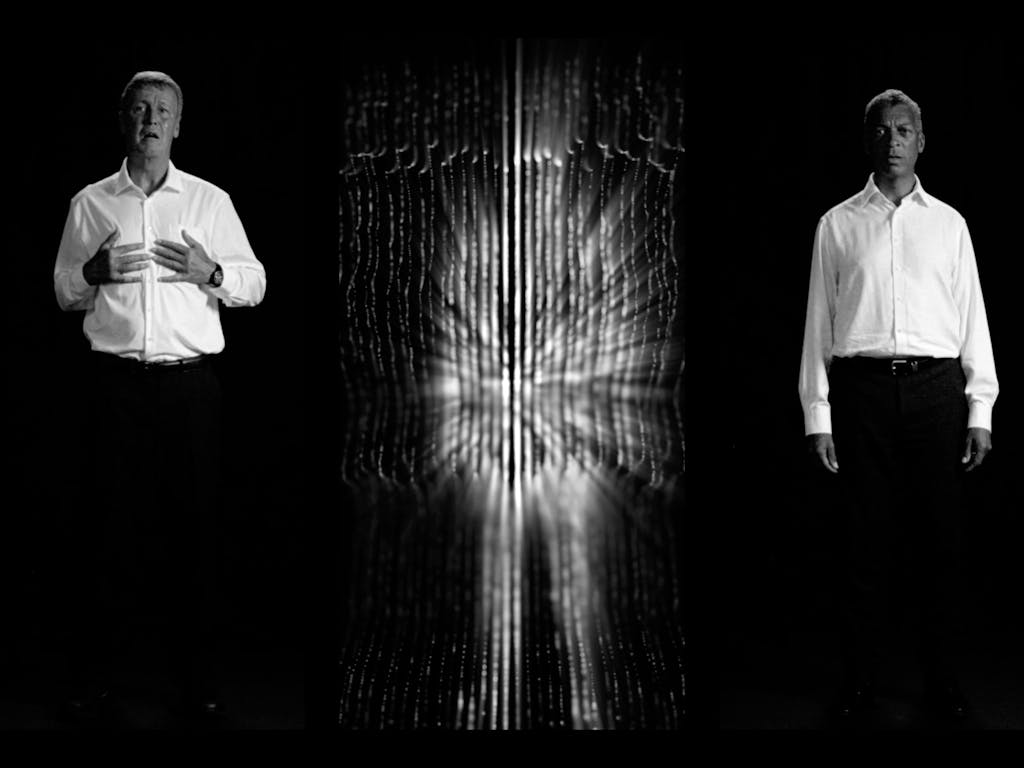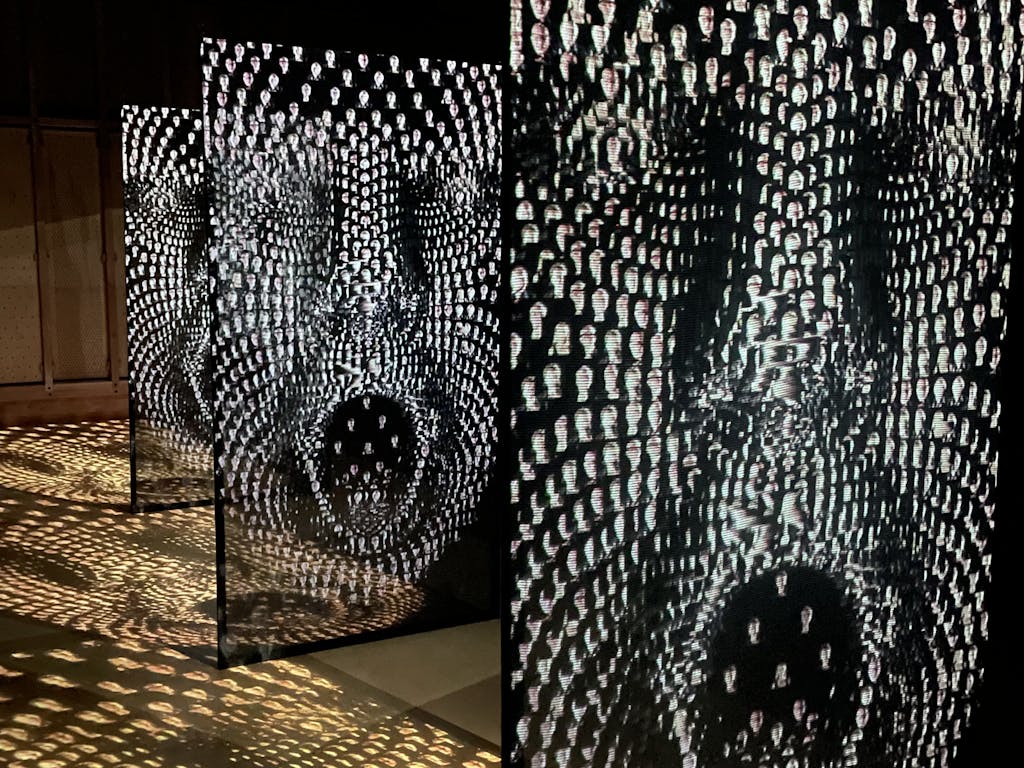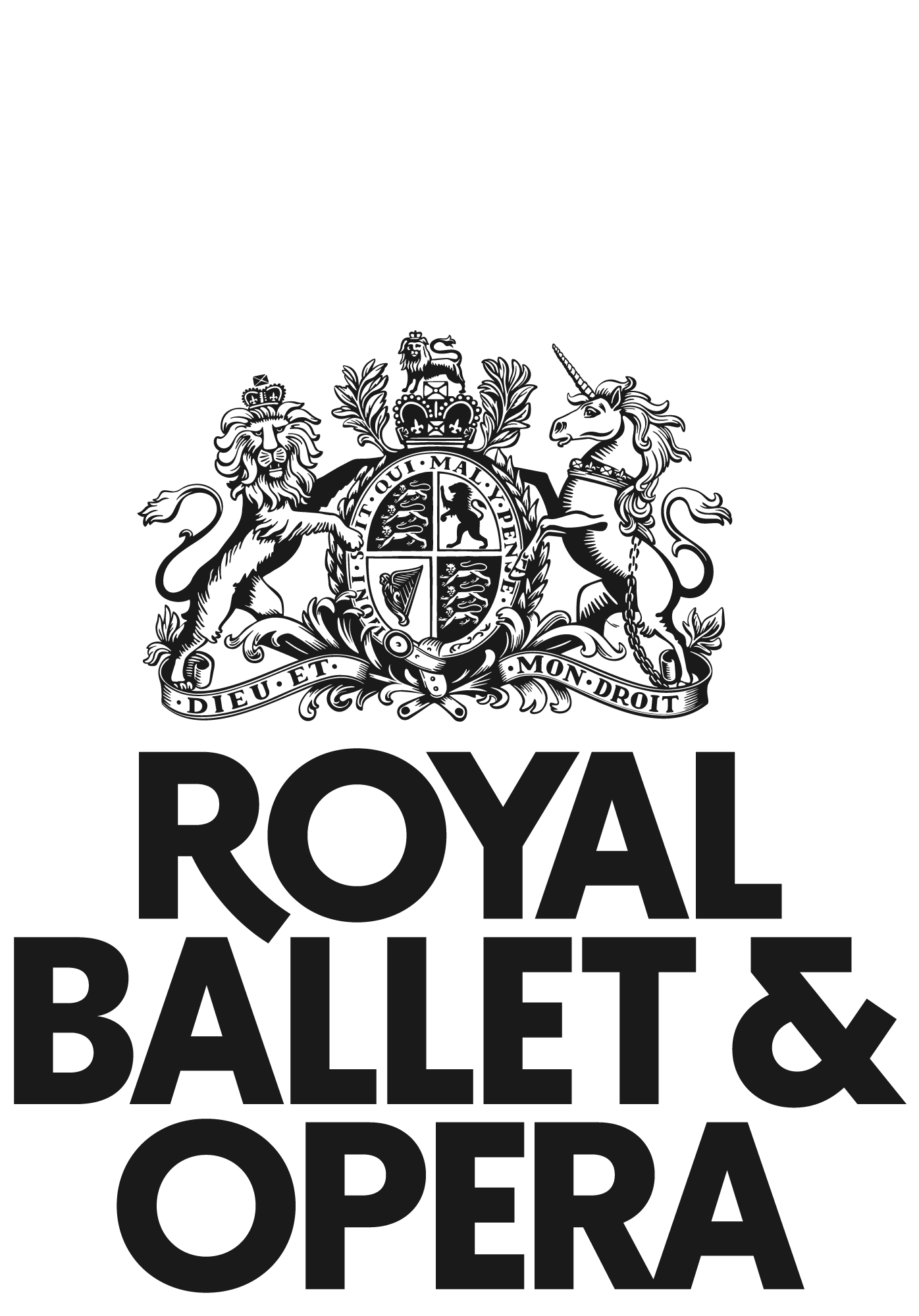The Sound Voice Project
Welcome
A welcome from the Linbury Theatre
In 2024, amidst a backdrop of information and sensory overload – day to night, at work and at play – it is rare that anything we consume has the power to stop us in our tracks. But eighteen months ago, Tanja Bage and Lucy Crowe did just that, for me. Their aria, ‘Tanja’, was my first experience of The Sound Voice Project and it transformed the way I thought about my own voice and the voices we choose to share within these hallowed walls. I ran home so fast that night, just to make sure I was in time to sing a goodnight song to my children and hug them that tiny bit tighter. The best opera does that to you; it forces you to see beauty in the mundanity of everyday life and confront the uncomfortable truths that come with being human.
It has long been an ambition to programme an operatic installation in the beautiful, flexible space of the Linbury Theatre. This work gives audiences a chance to stop and reflect, just a moment out of a busy day, and offers a different perspective on how we use our voices and our stages to tell stories. My thanks go to Hannah Conway for her brilliance, vision and tireless pursuit in breaking down barriers into opera. I hope these three extraordinary pieces spark something in you today as they did me.
Sarah Crabtree
Creative Producer
A welcome from The Sound Voice Project
The Sound Voice Project started as a series of conversations between 2016–9 with my friend and colleague Phillipa Anders at Britten Pears Arts. It was a deeply personal passion project from the start and I’m so proud now of the special team and friendships it has become. When my dad lost his speech, it was devastating; unthinkable to lose that precious connection. Over the years after we lost him, I realised that as a composer, writing opera and working with singers throughout my career, I’d never really deeply thought about the value and fragility of our voices. I’d taken everything for granted. I’d never truly appreciated why it is that we need our own, unique-sounding voice and what happens when that ability to express ourselves, to ‘sound’ like oneself, disappears. What are we left with? How we continue to be ourselves amongst the people we love?
These questions motivated me to draw together a team of unlikely collaborators. I wanted to gather those with experience of voice loss and their families, artists and professional experts in voice and explore what it means to have a voice and how voice and identity intersect. Healthcare, technology, professionals, biomedical researchers and neuroscientists were connected with those with lived experience of voice loss; affected by Parkinson’s, motor neurone disease and throat cancer. In partnership with the brilliant writer Hazel Gould and supported by creative producer Katherine Wilde and Dr Thomas Moors, we took them through an intense artistic process of exploration; singing, writing, exchanging stories, research and experiences. Singing was new for most and for many a terrifying prospect, so an equal, non-hierarchical space was established quickly! Mutual respect between people who would never normally meet in the same room grew and the teams became closely knit. We laughed, we cried and we discovered so much about what it is to be human and to have a voice.
The Sound Voice Project installation features three of the original six chamber works. Raw and personal, it is an intimate portrait of what it is to have a voice and to lose it. It is also a celebration of the fragility and beauty of our voices and their role in our lives. It’s so special to platform these voices at the Royal Ballet and Opera; to demonstrate their weight, value and immeasurable meaning within the art genre. The unique colour combination of both operatic and changed or lost voices can preciously communicate every nuance.
The Sound Voice Project has been a wonderful catalyst for innovation cross-sector. We’ve changed the course of a ground-breaking biomedical research project, transformed thinking and practice in healthcare and stimulated new commercial voice technology. Most importantly, however, I hope that we’ve created works that invite audiences to think about the value of their own voices and offer a small insight into the lives and stories of people who have lost theirs.
Hannah Conway
Composer and artistic director, The Sound Voice Project
www.hannahconway.co.uk
PAUL
Paul was written by composer Hannah Conway and writer Hazel Gould after many hours of interviews and collaborative conversation with Paul Jameson, who was diagnosed with motor neurone disease in 2017. The piece invites audiences to understand what ‘voice’ means to Paul as he loses his speech. Paul is a ‘dual aria’ – a piece for one character (Paul), though sung by two performers: Paul Jameson (the real voice) and baritone Roderick Williams (Paul’s imagined voice).

In Paul's words
‘As someone who has totally lost my voice, The Sound Voice Project helped me to think about speech and what it means. It empowered me to find a way to communicate effectively through music. The aria that's featured in the installation was beautiful, powerful and emotional. It made me feel as if I had my voice back again and I felt very connected to Roddy Williams who I performed the aria with.’
Read the libretto for Paul
I LEFT MY VOICE BEHIND
I Left My Voice Behind explores how the voice links us to our past, present and future identities, including vocal potential enabled by science and technology. It was written in collaboration with people who have survived throat cancer and have had life-saving laryngectomy treatment to remove their voice box, alongside healthcare professionals, and a team of biomedical researchers developing a groundbreaking implantable larynx. The piece is written for two choirs: one live choir (performed by people who have had laryngectomies, members of Shout at Cancer) and a second digital choir, constructed from recordings of Shout at Cancer members pre-cancer, when their voice boxes were still intact. The choirs are joined by solo professional cello, with a digital counterpart crafted from old recordings of that cellist, mirroring the duet between live and digital choirs and collectively exploring renewal, transformation, and the birth of new vocal identities.

In Shout at Cancer's words
‘It meant a great deal to the members of the laryngectomy choir to be part of The Sound Voice Project, and to see our story compellingly included in an opera about voice and identity. Our strong message of resilience was beautifully conveyed to the audience, with an added layer of accessibility that evoked empathy and understanding. This connection was even more poignant as the recording took place during the COVID-19 pandemic – a time when everyone could relate to the challenges of health threats, financial instability, and isolation. Such times highlight the strength we draw from our human connections, whether through friends, family, neighbours, or community, and the unifying power of the arts and culture in illuminating these shared experiences.’
Read the libretto for I Left My Voice Behind
TANJA
Tanja was 38 years old when she was diagnosed with a rare form of cancer growing behind her vocal cords in 2020. One week after diagnosis her voice box was removed during the COVID-19 pandemic. This piece charts her journey recovering from life-changing surgery complicated by social distancing and isolation. Having trained initially as a professional actor/singer, she is exploring how voice loss impacts her daily life as mother of two young children, her relationships, identity at the school gates and the stigmas attached to being a woman with a laryngectomy. The piece is for Tanja and professional soprano.

In Tanja's words
‘Around 6 months after I had my surgery, I became involved with the Shout at Cancer laryngectomy choir and collaborated on the amazing Sound Voice Project. With them I have performed at the Kings Place, the Festival of New, universities, churches and conferences. I have been interviewed on TV and radio about the project and my personal experience of losing my voice. My involvement with Shout at Cancer and Sound Voice gave me a new creative and expressive outlet at a time when everything was extremely raw and whilst I navigated my way through the post traumatic shock and grief of everything I had a been through, and has been a huge factor on how I have processed the loss of my voice.’
Read the libretto for Tanja
How to Experience
The main experience is The Sound Voice Project, a digital opera, in the Linbury Theatre. This is a ticketed event with timed entry. Audiences will enter via Door 2 in the Linbury Foyer to the auditorium and journey down to the performance space travelling through an immersive sound prologue composed especially for the RBO, created from voices submitted by members of the public. The Linbury Theatre will be transformed, with the stalls seating removed. The opera is presented in the round, projected onto three transparent gauzes in the centre of the space, with 360 degree surround-sound and seating placed around the perimeter. Once the performance has finished, ushers will guide the audience back up to the Linbury Foyer, exiting via Door 1.
The Linbury Foyer will host two additional free experiences – one is the Sound Voice Roundhouse, a wooden structure which will be built in the middle of the foyer. The dome has been designed to house 360 degree sound. Inside audiences can listen to additional content related to The Sound Voice Project. The content will be rolling automatically throughout the day, and features a BBC Radio 4 Documentary about the work, interviews with the creatives, and bonus works from The Sound Voice Project composed by Hannah Conway with words by Hazel Gould. Anyone is welcome to enter and enjoy this audio experience for as much or as little time as they would like.
The final experience is a photography exhibition, commissioned by the Royal Ballet and Opera, which will be on display in the corner of the foyer. This collaboration between photographer Serena Brown and Sound Voice Artistic Director and composer Hannah Conway displays images of those involved in the creation of The Sound Voice Project and celebrates the healthcare professionals, researchers, performers and creatives who together have evolved and contributed to this work. This exhibition will remain on display until 19 January 2025.
Running Time
The performance lasts approximately 30 minutes without an interval
Guidance
Suitable for ages 12+.
Themes of illness throughout.
The Sound Voice Project are collecting feedback about your experience. Read more and fill out the feedback survey.
Credits
PRODUCTION
Music HANNAH CONWAY
Words HAZEL GOULD
Video Design LUKE HALLS
Sound Design DAVID SHEPPARD
Creative Producer KATHERINE WILDE
Sound Voice Technical Producer and Production Manager
STEPH CLARKE
Sound Production ANDREW MELLOR, BRETT COX
Installation Producers (2021-22)
PATRICK DICKIE, TOM LOVATT
PAUL
Baritone RODERICK WILLIAMS
Voice PAUL JAMESON
Violin RAKHI SINGH
Piano HANNAH CONWAY
I LEFT MY VOICE BEHIND
Vocals SHOUT AT CANCER
Electrospit PUG HALLIDAY
Cello NICK TRYGSTAD
TANJA
Soprano LUCY CROWE
Voice TANJA BAGE
Violin MARIANNE HAYNES
Cello NICK TRYGSTAD
Piano HANNAH CONWAY
Resources
If audiences are affected by the themes or want to find out more, they can contact the below organisations.
- Shout At Cancer: A charity dedicated to supporting people after laryngectomy, the surgical removal of the voice box.
- Motor Neurone Disease Association: The MND Association focuses on improving access to care, research and campaigning for those people living with or affected by MND in England, Wales and Northern Ireland.
- Parkinson’s UK: A charity researching cures, and improving lives for those affected by Parkinson’s.
- Macmillan: The UK's leading cancer care charity
- Sing For Joy choirs in London: Sing for Joy London choirs are choirs of people affected by conditions such as Parkinson’s Disease and Multiple Sclerosis – including carers.
About Sound Voice
Founded in 2021, Sound Voice is a company specialised in creating powerful live and immersive vocal performance works by drawing together interdisciplinary experts; people with lived experience and professionals from the healthcare, scientific, biomedical, social research and technology sectors. Through unique collaborations, their internationally award-winning digital installations and performances platform voices and unheard narratives from marginalised groups. Their creation process and final artworks have instigated changes in thinking and practice cross-sector and have been a catalyst for multi-sector innovation. Awards include FEDORA Digital Prize, Alternate Realities Award, Sheffield Doc Fest and Classical:NEXT Innovation Award.
About FEDORA
The Sound Voice Project was awarded the FEDORA Digital Prize, supported by Kearney, in collaboration with the expert partner IMZ - International Music + Media Centre. The FEDORA Digital Prize advocates for new approaches to artistic expression and accessibility to opera and dance through digital innovation. It encourages creative experimentation, while promoting alternative ways of interacting with artists and audiences through digital tools and fostering interdisciplinary collaboration between sectors.
FEDORA - The European Circle of Philanthropists of Opera and Ballet is a non-profit organisation founded at the Palais Garnier in Paris in 2013, under the presidency of Jérôme-François Zieseniss as a tribute to Rolf Liebermann. It is now chaired by Stéphane Argyropoulos. The organisation encourages and supports the next generation of talent to bring innovative opera, dance, education, and digital projects to the stage to inspire tomorrow’s audiences with today’s narratives. FEDORA pursues its mission through the FEDORA Prizes, known today as the world’s largest competition for innovation in opera and dance. Over the past decade, FEDORA has supported 75 new artistic co-productions involving over 2,000 artists and creatives. The FEDORA Platform is also co-funded by the Creative Europe programme of the European Union.
FEDORA federates a network of over 130 cultural institutions in 28 countries, as well as individual and corporate members and foundations that constitute an interdisciplinary ecosystem to build a more sustainable and inclusive future for opera and dance, accessible to all.
Royal Opera House Covent Garden Foundation, a charitable company limited by guarantee incorporated in England and Wales (Company number 480523) Charity Registered (Number 211775)
